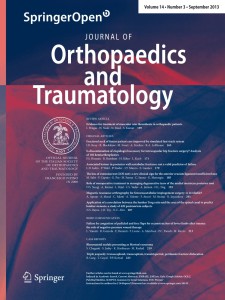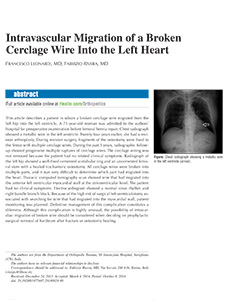 Bilateral double osteotomy in severe torsional malalignment syndrome: 16 years follow-up
Bilateral double osteotomy in severe torsional malalignment syndrome: 16 years follow-up
Background Torsional malalignment syndrome (TMS) is a well defined condition consisting of a combination of femoral antetorsion and tibial lateral torsion. The axis of knee motion is medially rotated. This may lead to patellofemoral malalignment with an increased Q angle and chondromalacia, patellar subluxation and dislocation. Conservative management is recommended in all but the most rare and severest cases. In these cases deformity correction requires osteotomies at two levels per limb. Materials and methods From 1987 to 2002 in our institution three patients underwent double femoral and tibial osteotomy for TMS bilateral correction (12 osteotomies). All patients were reviewed at mean follow-up of 16 years. Results At final follow-up no patients reported persistence of knee or hip pain.
Intravascular Migration of a Broken Cerclage Wire Into the Left Heart
Francesco Leonardi, MD; Fabrizio Rivera, MD
This article describes a patient in whom a broken cerclage wire migrated from the left hip into the left ventricle. A 71-year-old woman was admitted to the authors’ hospital for preoperative examination before femoral hernia repair. Chest radiograph showed a metallic wire in the left ventricle. Twenty-four years earlier, she had a revision arthroplasty. During revision surgery, fragments of the osteotomy were fixed to the femur with multiple cerclage wires. During the past 5 years, radiographic followup showed progressive multiple ruptures of cerclage wires. The cerclage wiring was not removed because the patient had no related clinical symptoms.

